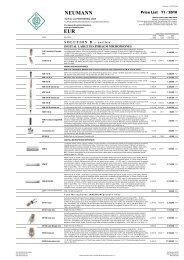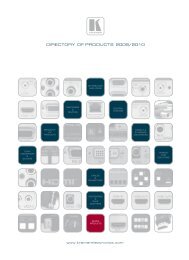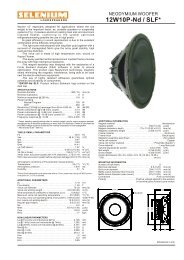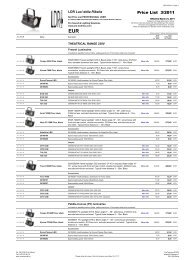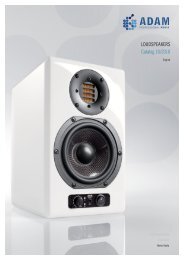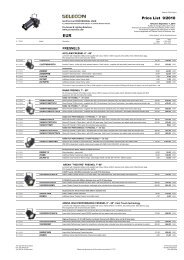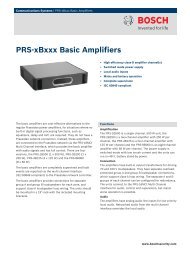Download - Yamaha Downloads
Download - Yamaha Downloads
Download - Yamaha Downloads
Create successful ePaper yourself
Turn your PDF publications into a flip-book with our unique Google optimized e-Paper software.
Case Study #1<br />
TV4<br />
(Stockholm, Sweden)<br />
Since its launch in 1990, the TV4 of Sweden has gone on to<br />
become the country’s largest commercial TV channel.<br />
Recently, the channel’s edit suites in Stockholm have<br />
undergone a massive multi-million kronor technical refit and<br />
– as further evidence that <strong>Yamaha</strong> Digital Mixing Engines<br />
(DMEs) are the perfect one-box solution for enhanced<br />
broadcast efficiency – six DME24Ns now form the heart of<br />
this cutting edge installation. Each DME unit is fitted with<br />
MY8-ADDA96 AD/DA cards, replacing a wide range of<br />
outboard studio devices, and in doing so, eliminating many of<br />
the problems experienced by broadcasters when using patch<br />
bays and equipment from a wide range of different<br />
manufacturers.<br />
JMG Support AB of the Bromma borough of Stockholm<br />
installed the system. “We chose the DME solution because, as<br />
a <strong>Yamaha</strong> dealer, we were familiar with the DME range and<br />
the many different ways in which it can be controlled,” says<br />
JMG Support’s Johan Küller. “Of course we also knew that<br />
audio quality is excellent, so the customer would be very<br />
happy with the end result.”<br />
Each DME system at TV4 is setup to control two edit suites<br />
and a recording/speaker booth shared between them. In<br />
addition to all monitoring, the DME systems also handle all<br />
switching and level control of audio recording sources,<br />
which include a non-linear editing (NLE) system, videotape<br />
Surround & Multi-Purpose Processor<br />
recorders (VTRs), and a microphone in the booth. The system<br />
also provides compression and limiting for the microphone.<br />
Another input comes from telephone hybrids that TV4 uses<br />
to accept calls from viewers and to record or broadcast their<br />
messages. The DME systems allow the output from these<br />
units to be monitored in the booth and in both edit suites, as<br />
well as feeding it to the inputs of the NLEs and to a PC<br />
located in the booth.<br />
“Our biggest challenge was to create a highly user-friendly<br />
interface,” says Johan. “The client wanted one-button<br />
solutions for the most common scenarios and, as we looked<br />
at all the different combinations of inputs and outputs, it<br />
became clear how complex the switching could become. In<br />
order to simplify the switching procedures to the level<br />
desired by TV4, digital signal processing (DSP) was the only<br />
practical solution."<br />
“Because of the client’s requirement for simplicity of<br />
operation, we also realized that we would need to produce<br />
custom control panels. So the complexity of the system, plus<br />
the requirement for simple switching and custom panels<br />
meant that the <strong>Yamaha</strong> DME Series was by far the best<br />
solution.”<br />
Custom control panels are located both in the booth and in<br />
each control room, which are connected to the serial ports of<br />
the DME24Ns. In the booth, the operator selects whether to<br />
record via microphone or telephone hybrid and whether to<br />
route the signal to be recorded within the booth or in one of<br />
the edit suites.<br />
Within the edit suites, the operator has a control panel for<br />
selecting whether to monitor the output of the NLE system<br />
or the signal from the microphone or telephone hybrid.<br />
Additionally, he can select whether to record from the booth<br />
or from VTR and can also set the recording level.<br />
“This was a challenging installation, particularly because the<br />
system needed to be very adaptable, with complex switching<br />
functions controlled in a very straightforward, intuitive way,”<br />
says Johan. “The DME solution has provided TV4 with an<br />
easy-to-use, high fidelity network offering vastly increased<br />
audio fidelity."<br />
“But the best thing is the flexibility of the system. Using the<br />
DME software, we can easily change things that would – in a<br />
non-DME installation – have required physical re-wiring,<br />
taking much longer and, of course, causing TV4 plenty of<br />
headaches. Now, the potential for such problems simply<br />
doesn’t exist.”<br />
Mainichi Broadcasting System, Inc.<br />
(Osaka, Japan)<br />
Galaxy Sub-control Room<br />
Mini Sub-control Room<br />
Surround & Multi-purpose Processor<br />
Mainichi Broadcasting System (MBS) uses a DME64N for both<br />
its Chichin Puipui show (a four-hour live broadcast) and<br />
Galaxy Sub program. Two other DME64Ns are employed as<br />
“mini subs” for news and sports programs – one being used<br />
for staff and commentator monitoring, while the other has<br />
been setup with surround-monitoring configurations for use<br />
as a monitoring processor. And setup in an outsidebroadcasting<br />
van, a further DME64N functions as a<br />
multi-purpose processor for golf and auto-racing broadcasts.<br />
7 8<br />
Case Study #2



